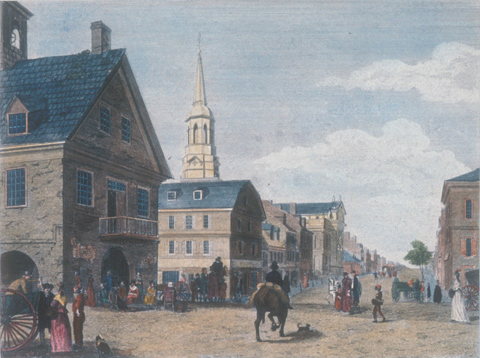Second Street North from Market St. with Christ Church
William Birch
Courtesy Independence National Historical Park, Karie Diethorn, Chief Curator, and with the kind assistance of library technician Andrea Ashby Leraris.[1]The prints in the INHP collection, which originated in various portfolio sets that preceded Birch’s book, The City of Philadelphia, in the State of Pennsylvania North America, as it appeared in … Continue reading
By 1803 the steeple of Christ Church had long been a prominent landmark for any visitor trying to orient himself in the city. The church, the first parish of the Church of England (Anglican) in Pennsylvania, was constructed between the years 1727 and 1744. Robert Smith completed the steeple in 1759. His early designs led to his commissions for many significant buildings constructed in the third quarter of the century, and for Benjamin Franklin’s house.
Christ Church is a classic example of Georgian architecture, which evolved during the era between 1714 and 1820 when Britain was ruled by three kings-George, and which represented modernity in the colonies and the new United States. In the left foreground is the pre-Georgian town hall or courthouse, built in 1707-1710. In keeping with a centuries-old urban tradition, a shopping center was located in the archway at ground level.
In Philadelphia’s decade as official national capital (1790-1800) and as residence of the first two U. S. Presidents, one of Bishop White’s parishioners at Christ Church was George Washington. The burial ground of the church at 5th and Arch, recently reopened to visitors, contains not only Franklin’s grave but also those of seven other signers of the Declaration of Independence.
Experience the Lewis and Clark Trail
The Lewis and Clark Trail Experience—our sister site at lewisandclark.travel—connects the world to people and places on the Lewis and Clark Trail.
Plan a trip related to Christ Church:

Notes
| ↑1 | The prints in the INHP collection, which originated in various portfolio sets that preceded Birch’s book, The City of Philadelphia, in the State of Pennsylvania North America, as it appeared in the Year 1800, measure approximately 18 by 14½ inches. |
|---|

